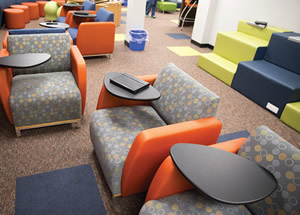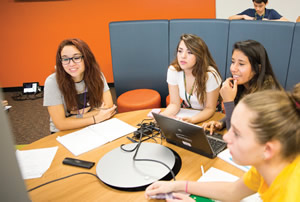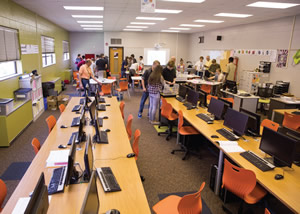Making School New Again
- By Michael Fickes
- 05/01/17

PHOTO COURTESY OF DES MOINES PUBLIC SCHOOLS
K-12 school architects and designers have been talking about redesigning the basic school classroom for years, but not much has really happened. Some new furnishings have arrived. Whiteboards are replacing blackboards, for instance. Typically, though, the changes have involved replacing one thing with another here and there. None of it has come close to something one would call a new classroom design.
But today, that is changing. In fact, classroom redesign is happening now — by and large, in school districts able to afford the educational technology that has emerged over the years.
Today’s educational technology is the key to classroom redesign. This movement, and it is a movement, isn’t about simply plopping a computer down on every student’s desk. It is, instead, about plugging entire classrooms and schools into a sophisticated technological network and creating something called an active learning environment.
Active learning means learning that is exploratory, creative and largely self-directed. An active learning environment does away with most, if not all, lecturing. Using course plans supplied by teachers, students research and study material on their own, developing and completing projects that illustrate what they have learned.
Again, teachers do not lecture in an active learning classroom. Instead, they move about the room questioning students one-on-one, seeking out where they are weak and providing them with research cues that will put them back on the right track.
Without technology that enables online searching, active learning classes would have to operate out of an excellent library. Even then, the process would take too much time, with students inching through the card catalog, slogging through stacks, scanning indexes and finally landing on a single piece of useful research.

PHOTO COURTESY OF DES MOINES PUBLIC SCHOOLS
Improved method of learning. Digital technology has taken the world by storm. It has touched every aspect of American society, so it only makes sense that this trend would have an impact on K-12 learning. Students, like the ones pictured above at Hoover High School, in Des Moines, Iowa, now work together on basic assignments and larger projects without having to meet at the library after school. Email and cloud applications make it simple for students to collaborate with each other remotely. The information the students find is instantly saved to a shared location and then accessed later on without waiting on each other to move forward.
Such a system wouldn’t work. Hence the alternative: Traditional classroom teaching. In a traditional system, of course, teachers lecture, provide photocopies of source articles, and take whole classes through the materials step by step. Some, if not many, students grow bored or get lost. Technology makes it possible to discard this traditional classroom approach and most, if not all, of its shortcomings.
How Active Learning Classrooms Work
Today technology can supercharge classrooms and make active learning possible.
For example, at the Tampa Preparatory School in Tampa, Fla., director of Technology Chad Lewis has designed and implemented an active learning environment.
“We adopted the active learning environment concept four years ago,” Lewis says. “This isn’t something that can be done in isolation. In coming up with an active learning concept that fit our school’s culture, we talked to teachers, students and administrators.
“We found that teachers and students don’t think about technology per se; they think about what is important in their classrooms. The teachers told us that they wanted collaborative environments that were flexible enough to change easily.
“Both teachers and students also wanted to tear down the traditional concept of neatly positioned rows of desks where some students sat in the front and others sat in the back. They wanted classrooms where every student had an equal audio and visual experience.”
Moreover, teachers wanted the ability to transform their classrooms on the fly, moving from a lecture environment (rows of desks facing front) to a collaborative environment (desks gathered into several small groupings for project work).
“When students alter their positions in the classroom this way, they will often lose site of the front of the room where the teacher generally stands or sits. Two large interactive projectors projecting onto whiteboard surfaces around the perimeter ensure every student can see projected content regardless of where they are sitting. Mobile desks allow students to easily collaborate in small groups, and the teacher can move around the room to assist students as necessary. Students can then share their work with the entire class by wirelessly connecting their iPads to the two projectors.”
In rooms equipped like this, teachers generally wear microphones that channel their voices through the rooms audio amplification system, ensuring that everyone can hear the teacher when he or she speaks.
“There is a huge benefit to using two projectors in each classroom, Lewis adds. “With one projector, you can see a student asking a question or a teacher answering the question. With two projectors, both the teacher and student can be seen.”
In addition, two projectors enable teachers to move around the room without losing video coverage.
The Four C’s
“Comments from teachers and students led us to conceive of today’s active learning environment as one based on the four C’s of 21st-century learning,” says Lewis.
What are the four C’s?
“Our four C’s are collaboration, communication, creativity and critical thinking. These are the main components of an active learning environment. When they come together, you can have an active, dynamic, flexible learning environment.”
Students asked for different lighting, too. Many students reported suffering from headaches when working under traditional fluorescent lighting.
Students also wanted more comfortable seats. Current research notes that students comfortable in their chairs do better in class. Several manufacturers now offer adjustable chairs for students of all sizes and builds.
In addition, students can move comfortably while sitting in today’s classroom seating. As students move-side-to side and front-to-back, the chair’s components will bend and follow.

PHOTO COURTESY OF DES MOINES PUBLIC SCHOOLS
Collaborative learning. The digital collaboration that is going on in K-12 classrooms is indicative of the way the workplace is shifting to more remote access of information and global working relationships that operate with ease. Along with easy sharing of information, K-12 students today can access research in ways that were unheard of when their parents were in school. Electronic academic databases provide all of the information a student needs to research an assignment or write a term paper, but with much less of the manpower needed.
Technology That Alters Teaching
Active learning environments don’t only change the way students learn, they give teachers new tools.
Within the past year, Hoover High School, in Des Moines, Iowa, received a Science, Technology, Engineering and Mathematics (STEM) grant to rethink what classrooms look like and to create innovative learning spaces.
“We are implementing Epson Britelink projectors in every classroom in the school district, about 2,500 projectors in all,” says Dan Warren, director of technology operations, central stores and printing services for Des Moines Public Schools.
The district’s Britelink facilities include classrooms outfitted with a STEM Grant from the Governor’s STEM Advisory Council. “We started out by designing a STEM classroom at one of our high schools,” Warren says. “We created several collaboration areas — one area where one student can study and others where three to five students can collaborate. We implemented projectors there.
Warren says the district started out by purchasing technology with grant funds but couldn’t sustain that model — sometimes grants don’t come through. When that happened, the district moved to a centralized approach to funding.
“We’re not a one-to-one technology district, but I would say that we are a modified one-to-one district. We have devices available for students while at school — they can’t take those devices home. Some students bring their own devices.
“We try to recommend brands so that we have the same devices as much as possible.
“We are working toward a model where we replace devices every four years, which is a leasing model.”
At the same time, Warren is reviewing district RFPs for a Learning Management System (LMS), which he plans to begin implementing in phases starting in the fall of this year.
“An LMS is an online portal,” Warren says. “Teachers and students log on. Teachers can assign projects. Students work online in an LMS, and then submit their work to their instructors.”
What does Warren ultimately expect from all these classroom technologies and redesigned classrooms? “It is all about personalized learning,” he says. “The idea is to take classroom learning from a teacher-based learning environment to a student-based learning environment — where students control the learning. We refer to the end-product as a ‘school of rigor.’
In the end, student-based learning translates into project-based learning created and managed by the students themselves. Experience suggests that technology such as projectors and learning management systems have proven key to the success of project-based learning — the next generation’s vastly improved method of teaching and learning.
This article originally appeared in the issue of .